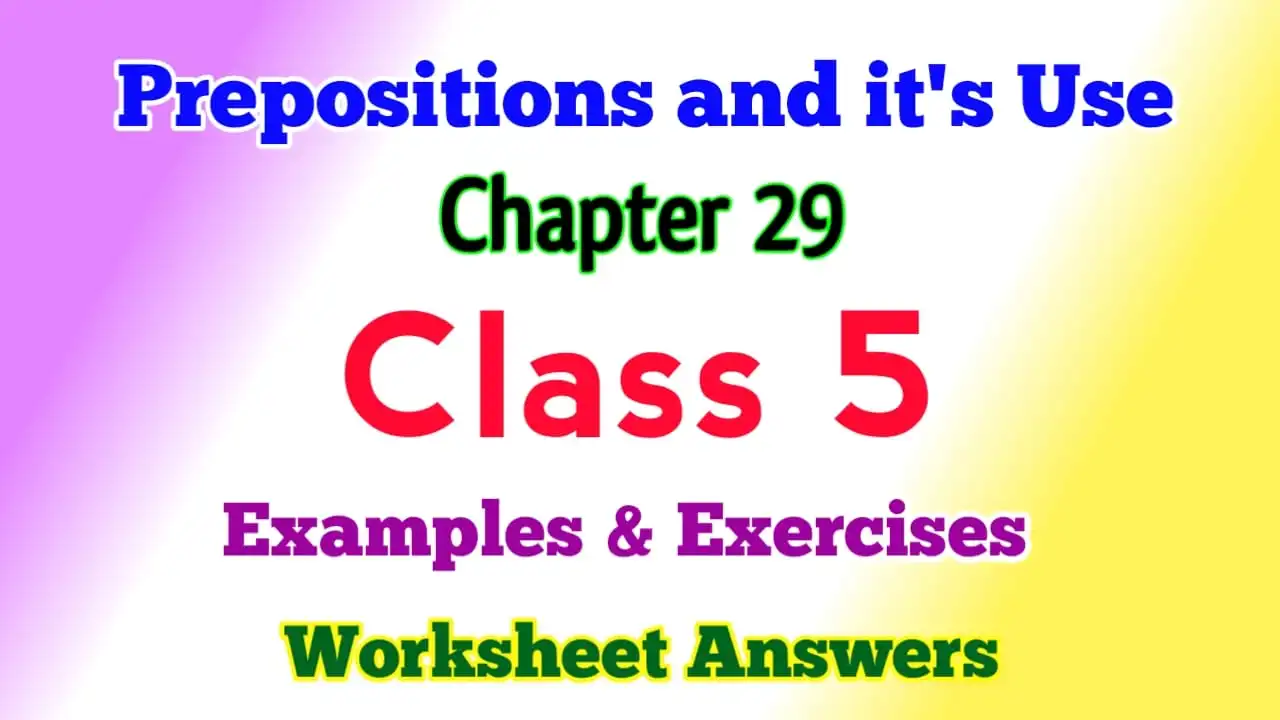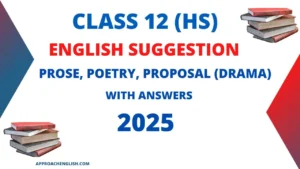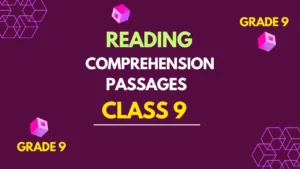Preposition and its Use Class 5 English Grammar has been prepared for learning English Grammar of Class 5 under CBSE, ICSE, and Other State boards as Lesson No 29. Class 5 students in their English Grammar learning process will get help from the Preposition and its use Class 5 English Grammar to achieve better speaking and writing skills in English.
This Lesson 29, Preposition and its Use Class 5 English Grammar contains – Preposition Definition, and Some common prepositions, Kinds of Prepositions, Difference Adverb and Preposition with a practice worksheet at the end for better knowledge for class 5.
English Grammar eBook Class 5
Preposition Definition
These words tell us where someone or something is in relation to something else.
A preposition is a word that shows the position of things and people in relation to someone, something or some place.
Some common prepositions are-
- in
- on
- of
- across
- off
- through
- before
- behind
- near
- over
- beside
- inside
- outside
- with
- to
- into,
- under
- except
- between
- till
- until
Worksheet 1: Preposition and its use Class 5 English Grammar
A. Underline the prepositions in these sentences.
1. I walked to the shop.
2. The boy jumped off the wall.
3. I have never heard of him before.
4. Potatoes grow under the ground.
5. Hide behind the door till they leave.
6. Why don’t you wait outside the office?
7. The bird built its nest between the branches of the tree.
8. Please collect all the books and place them on the table.
9. They climbed over the fence and went into the garden next door.
10. The pilgrims went to the bank of the Ganga for a dip in the holy river.
Kinds of Prepositions
There are different kinds of prepositions.
- Prepositions of place.
- Prepositions of time.
- Prepositions of movement
Prepositions of place.
Prepositions that tell us about the position of things are called prepositions of place.
Example:
- He is waiting for us at home.
- The winner is on the victory stand.
- The children are in the hall.
- Are you going to school now?
- The town lies halfway between Delhi and Jaipur.
- I hung my coat behind the door.
- The cat is under the chair.
- Someone has parked his car in front of our gate.
- I put the tablecloth over the table.
- The bell was hanging above the door.
The highlighted prepositions show where something is located.
Prepositions of time.
Prepositions that tell us when something happened are called prepositions of time.
Example:
- Our classes begin at 9 a.m.
- I often go for a swim in the morning.
- The party is on Sunday.
- You must finish the work by 9 p.m.
- The school will remain closed till 1 January.
- The office will remain closed until further notice.
- We will be home by 5 o’clock.
- I have not seen her since March.
- They have been living here for five years.
- He was sleeping during the meeting.
- My mother gets up before dawn.
- The museum is open from 10:00 a.m.
The highlighted prepositions refer to specific points of time.
Prepositions of movement
Prepositions that are used to show movement to or from a place are called prepositions of movement
Example:
- Look to your left and you will see your destination.
- She walked through the door.
- Can you jump over the fence?
- They walked along the river.
- The man walked around the garden.
- He ran up the stairs.
- Run across to Mohan’s house and ask him to come over.
- The rocks rolled down the hill.
- The ball went over his head.
- The principal walked towards the student.
- The boys dived into the pool.
The highlighted prepositions show movement.
Worksheet 2: Preposition and its use Class 5 English Grammar
B. Fill in the blanks with suitable prepositions.
1. She ran the door.
2. They walked the city.
s. The boy fell the river.
4. I live 52 Palam Street.
5. The plane flew Jaipur.
6. The ground shook her.
7. My wallet is the briefcase.
8. The train went through the tunnel.
9. I will meet you at the airport.
10. Her bag was the chair.
11. I moved Germany in 1998.
12. The thief climbed the wall.
13. The trekkers walked the hill.
14. The satellite dish is the roof.
15. I have put the milk the fridge.
16. The party will start 8:00 p.m.
17. Throw the trash the dustbin.
18. The plane landed the runway.
19. There is a secret tunnel the city.
20. The child was sitting the chair.
21. The boy threw the ball the river.
22. The child spilt the milk the carpet.
23. I am travelling Sweden tomorrow.
24. We followed the road that ran the forest.
25. The toothpaste is in the cabinet the sink.
Difference Adverb and Preposition
Sometimes, we can confuse prepositions with adverbs. Let us learn to identify prepositions from adverbs. Read these sentences.
Adverb or Preposition?
Example:
- Karan ran down the
- We met outside the mall.
- Get inside the room.
In these sentences, the highlighted words are prepositions because each preposition is followed by a noun which is known as the object of the preposition.
Example:
- He sat down.
- We met outside.
- Get inside.
In these sentences, the highlighted words are adverbs because they modify the verbs that precede them.
Worksheet 3: Preposition and its use Class 5 English Grammar
C. Identify whether the highlighted words are prepositions (P) or adverbs (A).
1. Come inside.
2. Please stand outside.
3. An eagle circled above.
4. I had not met him before.
5. I looked out.
6. I left my notebook behind.
7. The rain came down heavily.
8. The cat slept inside the box.
9. We are going out at 8:00 p.m.
10. The cat was behind the curtain.
11. The children are playing outside.
12. The train went through the tunnel.
13. Leave the shoes outside the front door.
14. We reached half an hour before the show.
15. There was a huge beanstalk outside Jack’s bedroom window.
Class 5 English Grammar: All Topics & Chapters????:
Chapter 1. Parts of speech
Chapter 2. The sentence and Types
Chapter 3. Subject and Predicate
Chapter 4. Nouns and their Types
Chapter 5. Noun and Number
Chapter 6. Noun and Gender
Chapter 7. Articles
Chapter 8. Pronouns and their Classifications
Chapter 9. Verbs and Types of Verbs
Chapter 10. Regular Verbs Irregular Verbs List
Chapter 11. Subject and Verb Agreement
Chapter 12. Simple Present Tense
Chapter 13. Present Continuous Tense
Chapter 14. Present Perfect Tense
Chapter 15. Present Perfect Continuous Tense
Chapter 16. Simple Past Tense
Chapter 17. Past Continuous Tense
Chapter 18. Past Perfect Tense
Chapter 19. Past Perfect Continuous Tense
Chapter 20. Simple Future Tense
Chapter 21. Future Continuous Tense
Chapter 22. Future Perfect Tense
Chapter 23. Future Perfect Continuous Tense
Chapter 24. Tense Exercises
Chapter 25. Modal Verbs
Chapter 26. Adjectives and their Types
Chapter 27. Degree of Adjectives
Chapter 28. Adverbs and Comparison
Chapter 29. Prepositions and their Uses
Chapter 30. Conjunctions
Chapter 31. Direct and Indirect Speech
Chapter 32. Transformation of Sentences
Chapter 33. Punctuation







